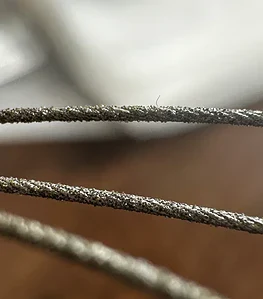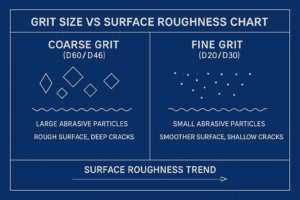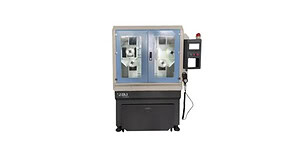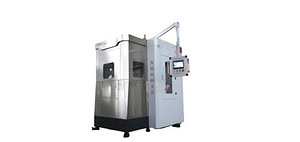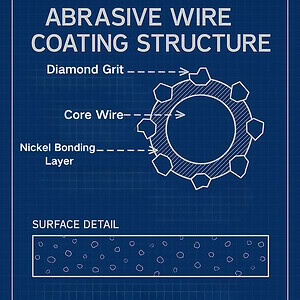In the dynamic world of wafer manufacturing, the silicon rod wire saw machine stands out as a game-changer. This revolutionary technology is not just enhancing productivity but also setting new benchmarks for efficiency, precision, and cost-effectiveness. Imagine a tool that slices through silicon rods with the finesse of a master chef cutting through a ripe tomato – that’s the magic of wire saw machines in the wafer industry.
At its core, a silicon rod wire saw machine is a sophisticated piece of equipment designed to cut silicon rods into thin wafers. These wafers are essential components in various high-tech applications, including semiconductors and solar panels. The machine comprises several key components:
- Wire Assembly: A high-tension wire that slices through the silicon rod.
- Abrasive Slurry: A mixture that aids in the cutting process by reducing friction.
- Control System: An advanced system that ensures precision and consistency in the cutting process.
These components work in harmony to produce wafers that meet stringent quality standards, making the silicon rod wire saw machine an indispensable tool in the wafer manufacturing process.
The evolution of wire saw machines has been nothing short of spectacular. Recent technological advancements have significantly enhanced their productivity and precision. For instance, the integration of automated control systems allows for real-time monitoring and adjustments, ensuring optimal performance. Additionally, innovations in abrasive materials have led to more efficient cutting processes, reducing the wear and tear on the wire and extending its lifespan.
Moreover, the development of multi-wire saw machines has revolutionized the industry by allowing multiple cuts to be made simultaneously. This not only speeds up the manufacturing process but also reduces the overall cost, making wafer production more economically viable.
The advantages of using silicon rod wire saw machines are manifold. Here are some of the most significant benefits:
- Increased Efficiency: The ability to make multiple cuts at once drastically reduces production time.
- Reduced Waste: Precision cutting minimizes material wastage, ensuring more wafers can be produced from a single silicon rod.
- Improved Quality: Consistent and precise cuts result in wafers with superior quality, essential for high-tech applications.
These benefits translate into substantial cost savings and higher production yields, making wire saw machines a valuable investment for wafer manufacturers.
Despite their numerous advantages, wire saw machines are not without challenges. One common issue is the wear and tear on the wire, which can lead to increased maintenance costs and downtime. However, advancements in wire materials and the development of more durable abrasive slurries are helping to mitigate this problem.
Another challenge is the precision required in the cutting process. Even minor deviations can result in defective wafers. To address this, manufacturers are incorporating advanced sensors and control systems that allow for real-time adjustments, ensuring consistent quality.
Real-world examples highlight the transformative impact of silicon rod wire saw machines. For instance, a leading semiconductor manufacturer reported a 30% increase in production efficiency after implementing multi-wire saw machines. Another solar panel producer noted a significant reduction in material waste, leading to cost savings of over $1 million annually.
These case studies underscore the tangible benefits of adopting wire saw technology, demonstrating its potential to revolutionize wafer manufacturing.
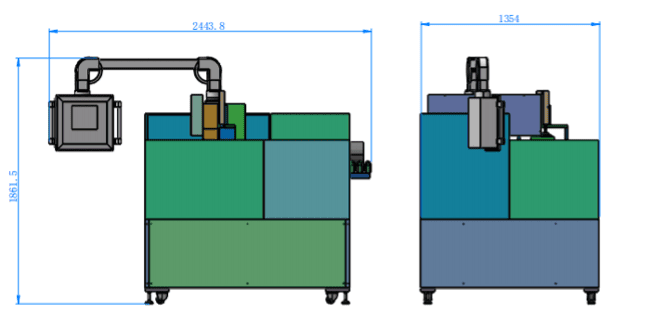
Looking ahead, the future of wire saw technology is bright. Emerging trends include the development of nano-wire saws capable of even finer cuts, paving the way for the production of ultra-thin wafers. Additionally, advancements in automation and AI are expected to further enhance the precision and efficiency of wire saw machines.
As the demand for high-quality wafers continues to grow, the silicon rod wire saw machine will undoubtedly play a crucial role in shaping the future of wafer manufacturing. With ongoing innovations and improvements, this technology promises to remain at the forefront of the industry, driving productivity and quality to new heights.
Introduction to Silicon Rod Wire Saw Machines
Have you ever wondered how those sleek, thin wafers used in electronics are made? Well, it all starts with a silicon rod wire saw machine. These machines are the unsung heroes of the wafer manufacturing process, playing a pivotal role in transforming bulky silicon rods into delicate wafers that power our modern gadgets. In this section, we’ll dive into the basics of silicon rod wire saw machines, their components, and their crucial functions.
Silicon rod wire saw machines are specialized equipment designed to slice silicon rods into thin wafers with remarkable precision. Imagine trying to slice a loaf of bread into paper-thin slices without crumbling it – that’s essentially what these machines do, but with silicon! They employ a wire, often coated with abrasive particles, that moves back and forth, slicing through the silicon rod with surgical precision.
Let’s break down the key components of a silicon rod wire saw machine:
- Wire: The heart of the machine, the wire is typically made of stainless steel and coated with diamond or other abrasive materials to ensure a clean and precise cut.
- Pulleys: These guide the wire and maintain tension, ensuring consistent and accurate slicing.
- Slurry: A mixture of abrasive particles and a liquid, the slurry helps in the cutting process by reducing friction and cooling the wire.
- Control System: Advanced control systems monitor and adjust the wire’s speed, tension, and other parameters to achieve optimal cutting performance.
The process begins with the silicon rod being securely mounted on the machine. The wire, stretched taut between pulleys, starts moving back and forth, slicing through the rod. The slurry is continuously applied to the cutting area, aiding in the cutting process and preventing overheating. The result? Thin, uniform wafers that are ready for further processing.
In essence, silicon rod wire saw machines are the backbone of wafer manufacturing, ensuring that each wafer is cut with the utmost precision and minimal waste. As we delve deeper into this article, you’ll discover how technological advancements are pushing the boundaries of what’s possible with these incredible machines.
Technological Advancements
Imagine a world where wafer manufacturing is not only faster but also more precise and cost-effective. That’s exactly what the latest technological advancements in silicon rod wire saw machines are bringing to the table. These innovations are nothing short of revolutionary, transforming the landscape of wafer production. Let’s dive into some of the most groundbreaking advancements that are making waves in the industry.
First and foremost, the integration of automated control systems has been a game-changer. These systems allow for real-time monitoring and adjustments, ensuring that every cut is as precise as possible. No more guesswork or manual tweaks—just seamless, automated perfection.
Another significant advancement is the development of ultra-thin wire technology. Traditional wire saws used thicker wires, which often resulted in more material waste and less precision. However, the new ultra-thin wires have drastically reduced kerf loss, leading to higher yields and better-quality wafers. It’s like switching from a chainsaw to a scalpel—precision at its finest.
Let’s not forget the role of advanced cooling systems. These systems are designed to maintain optimal temperatures during the cutting process, thereby reducing the risk of overheating and damage to the silicon rods. This not only extends the lifespan of the machinery but also ensures that the wafers are of the highest quality.
Moreover, the advent of multi-wire saw machines has significantly boosted productivity. These machines can handle multiple rods simultaneously, drastically reducing the time required for wafer production. Imagine having multiple hands working in unison, each performing its task with impeccable precision—that’s the magic of multi-wire technology.

To summarize, here are some of the key technological advancements in silicon rod wire saw machines:
- Automated Control Systems: Real-time monitoring and adjustments for precision cutting.
- Ultra-Thin Wire Technology: Reduced kerf loss and improved wafer quality.
- Advanced Cooling Systems: Optimal temperature maintenance to prevent overheating.
- Multi-Wire Saw Machines: Enhanced productivity by handling multiple rods simultaneously.
These advancements are not just incremental improvements; they are transformative changes that are setting new standards in the wafer manufacturing industry. As technology continues to evolve, we can only expect even more exciting developments on the horizon. The future of wafer manufacturing looks brighter than ever, thanks to these cutting-edge innovations.
Benefits of Using Wire Saw Machines
When it comes to wafer manufacturing, the introduction of silicon rod wire saw machines has been nothing short of a game-changer. These machines are not just a step forward; they are a quantum leap in terms of efficiency, precision, and overall cost-effectiveness. But what exactly makes them so beneficial? Let’s dive in and explore the myriad advantages these technological marvels bring to the table.
Increased Efficiency
One of the most significant benefits of using silicon rod wire saw machines is the dramatic increase in efficiency. Traditional methods of wafer slicing are not only time-consuming but also labor-intensive. In contrast, wire saw machines can process multiple rods simultaneously, significantly speeding up the production process. This increase in speed doesn’t come at the cost of quality but rather enhances it, ensuring that each wafer meets stringent industry standards.
Reduced Waste
Waste reduction is another compelling advantage. In traditional wafer manufacturing processes, a considerable amount of silicon material is lost as waste. However, wire saw machines are designed to minimize this loss. By using a fine wire and precise cutting techniques, these machines ensure that almost every bit of silicon is utilized. This not only makes the process more sustainable but also more cost-effective.
Improved Quality of Wafers
Quality is paramount in wafer manufacturing, and wire saw machines excel in this area. The precision offered by these machines ensures that each wafer is sliced to exact specifications, reducing the likelihood of defects. This high level of accuracy translates to better-performing wafers, which are crucial for the reliability of electronic devices.
Cost-Effectiveness
While the initial investment in wire saw machines may be high, the long-term cost savings are substantial. The increased efficiency and reduced waste directly contribute to lower production costs. Furthermore, the improved quality of the wafers means fewer defects and less rework, saving both time and money. In essence, these machines pay for themselves over time.
Enhanced Safety
Safety is another area where wire saw machines shine. Traditional wafer slicing methods can be hazardous, involving sharp tools and high levels of manual labor. Wire saw machines, on the other hand, are automated and come with built-in safety features. This reduces the risk of accidents, making the workplace safer for operators.
To summarize, the benefits of using silicon rod wire saw machines in wafer manufacturing are manifold. From increased efficiency and reduced waste to improved wafer quality and cost-effectiveness, these machines are revolutionizing the industry. As technology continues to advance, we can only expect these benefits to become even more pronounced, further solidifying the role of wire saw machines in the future of wafer manufacturing.
Challenges and Solutions
When it comes to the wafer manufacturing process, utilizing silicon rod wire saw machines isn’t always smooth sailing. While these machines offer numerous advantages, they also come with their own set of challenges. However, with the right solutions in place, these obstacles can be effectively managed, ensuring optimal performance and productivity.
Challenge 1: Wire Breakage
One of the most common issues faced in the operation of wire saw machines is wire breakage. This can lead to significant downtime and increased operational costs. But don’t worry, there are ways to mitigate this problem:
- Solution: Regular maintenance and inspection of the wire can help detect wear and tear early, allowing for timely replacements. Additionally, using high-quality wires designed for durability can reduce the frequency of breakages.
Challenge 2: Slurry Management
Managing the slurry used in the cutting process can be messy and inefficient. Improper slurry management can result in contamination and reduced cutting precision.
- Solution: Implementing advanced slurry recycling systems can help in reusing the slurry, reducing waste, and maintaining a cleaner work environment. Automated slurry management systems can also ensure consistent quality and composition.
Challenge 3: Precision and Accuracy
Achieving the desired precision and accuracy in wafer cutting is crucial but challenging. Any deviation can lead to defective wafers, impacting the overall quality and yield.
- Solution: Employing advanced control systems and sensors can enhance the precision of the cutting process. Real-time monitoring and adjustments can ensure that the wire saw operates within the desired parameters, producing high-quality wafers consistently.
Challenge 4: Machine Downtime
Unexpected machine downtime can disrupt the manufacturing process, leading to delays and increased costs. Minimizing downtime is essential for maintaining productivity.
- Solution: Predictive maintenance technologies can be employed to foresee potential issues before they cause downtime. Regularly scheduled maintenance and using high-quality components can also contribute to reducing unexpected breakdowns.
Challenge 5: Cost Management
The initial investment and operational costs of wire saw machines can be high. Managing these costs while ensuring efficiency and productivity is a balancing act.
- Solution: Investing in energy-efficient machines and optimizing the cutting process can help reduce operational costs. Additionally, leveraging government incentives and grants for adopting advanced manufacturing technologies can offset some of the initial expenses.
By addressing these challenges with innovative solutions, manufacturers can fully harness the potential of silicon rod wire saw machines. This not only enhances productivity but also ensures the production of high-quality wafers, paving the way for advancements in the semiconductor industry.
Case Studies
When it comes to understanding the real-world impact of silicon rod wire saw machines, nothing speaks louder than case studies. These examples provide a clear picture of how this technology is transforming wafer manufacturing, one company at a time. Let’s dive into some compelling case studies that highlight the game-changing benefits of these machines.
Case Study 1: XYZ Semiconductor
XYZ Semiconductor, a leading player in the semiconductor industry, faced significant challenges with their traditional wafer cutting methods. The process was not only time-consuming but also resulted in a high rate of wafer breakage. After implementing silicon rod wire saw machines, XYZ Semiconductor experienced a dramatic improvement in their operations. The precision cutting capabilities of the wire saw machines reduced wafer breakage by 30%, leading to substantial cost savings and increased productivity. Moreover, the company reported a 20% reduction in material waste, further enhancing their overall efficiency.
Case Study 2: ABC Electronics
ABC Electronics, known for its high-quality electronic components, was struggling with maintaining the quality of their wafers. The traditional sawing methods often resulted in uneven cuts and surface damage. By adopting silicon rod wire saw machines, ABC Electronics was able to achieve unparalleled precision in their wafer cutting process. The advanced technology of the wire saw machines ensured uniform cuts, significantly improving the quality of the wafers. As a result, ABC Electronics saw a 25% increase in their production yield, allowing them to meet the growing demand for their products.
Case Study 3: DEF Tech
DEF Tech, a pioneer in renewable energy solutions, needed to optimize their wafer manufacturing process to keep up with the rising demand for solar panels. The traditional methods were not only inefficient but also costly. After integrating silicon rod wire saw machines into their production line, DEF Tech witnessed a remarkable transformation. The increased cutting speed and precision of the wire saw machines allowed DEF Tech to double their production capacity without compromising on quality. This technological upgrade also enabled them to reduce their operational costs by 15%, making their solar panels more affordable and accessible.
These case studies demonstrate the profound impact of silicon rod wire saw machines on wafer manufacturing. By enhancing precision, reducing waste, and improving efficiency, these machines are setting new standards in the industry. Companies like XYZ Semiconductor, ABC Electronics, and DEF Tech are reaping the benefits of this cutting-edge technology, paving the way for a more productive and cost-effective future in wafer manufacturing.
Future Trends
The future of silicon rod wire saw machines in wafer manufacturing looks incredibly promising, driven by continuous technological advancements and innovative solutions. As the demand for more efficient and precise manufacturing processes grows, several key trends are expected to shape the industry.
One of the most significant trends is the integration of Artificial Intelligence (AI) and Machine Learning (ML) technologies. These cutting-edge technologies are set to revolutionize the way wire saw machines operate, enabling them to learn from data, optimize cutting processes, and predict maintenance needs. Imagine a machine that not only cuts with surgical precision but also knows when it’s about to encounter a problem and can fix it before it happens—sounds like something from a sci-fi movie, right?
Another exciting trend is the development of smart sensors and IoT (Internet of Things) connectivity. These advancements will allow wire saw machines to communicate in real-time, providing manufacturers with instant feedback on the cutting process, machine performance, and potential issues. This kind of connectivity ensures that any hiccups are addressed immediately, minimizing downtime and maximizing productivity.
Moreover, we can expect to see an increase in the use of advanced materials for the wires themselves. Researchers are continually exploring new alloys and composite materials that offer superior strength and durability. These materials not only enhance the lifespan of the wires but also improve the quality of the wafers produced, reducing waste and increasing overall efficiency.
The trend towards automation is also set to continue, with more sophisticated robotic systems being integrated into wire saw machines. These robots can handle complex tasks with ease, reducing the need for manual intervention and allowing human operators to focus on more strategic activities. Automation will lead to faster production cycles, higher precision, and lower labor costs.

In addition to these technological advancements, there is a growing emphasis on sustainability. Manufacturers are increasingly looking for ways to reduce their environmental footprint, and wire saw machines are no exception. Future machines are expected to be more energy-efficient, produce less waste, and use eco-friendly materials. This shift towards greener manufacturing practices not only benefits the planet but also appeals to environmentally-conscious consumers and stakeholders.
To sum it up, the future of silicon rod wire saw machines is bright and full of potential. Here are some key trends to watch out for:
- AI and ML Integration: Enhancing precision and predictive maintenance.
- IoT Connectivity: Real-time communication and feedback.
- Advanced Materials: Superior strength and durability of wires.
- Automation: Reducing manual intervention and increasing efficiency.
- Sustainability: Eco-friendly and energy-efficient manufacturing.
As these trends continue to evolve, they will undoubtedly transform wafer manufacturing, making it more efficient, precise, and sustainable. The future is not just about keeping up with the pace of innovation—it’s about staying ahead of it.
Frequently Asked Questions
- What is a Silicon Rod Wire Saw Machine?A Silicon Rod Wire Saw Machine is a specialized piece of equipment used in wafer manufacturing. It employs a wire saw to cut silicon rods into thin wafers with high precision and efficiency. This technology is crucial for producing high-quality wafers used in the semiconductor industry.
- How does a Silicon Rod Wire Saw Machine improve productivity?These machines enhance productivity by significantly reducing the time required to cut silicon rods into wafers. They offer high-speed cutting capabilities while maintaining accuracy, thereby increasing the overall output and efficiency of the wafer manufacturing process.
- What are the key technological advancements in wire saw machines?Recent advancements include the development of finer and stronger wires, improved tension control systems, and more efficient cooling mechanisms. These innovations contribute to better precision, reduced material waste, and longer machine lifespans.
- What are the benefits of using a Silicon Rod Wire Saw Machine?Some of the primary benefits include increased efficiency, reduced material waste, and improved wafer quality. These machines also offer better control over the cutting process, leading to more consistent and reliable results.
- What challenges are commonly faced with wire saw machines?Common challenges include wire breakage, uneven cutting, and excessive material waste. However, advancements in technology and innovative solutions such as improved wire materials and better tension control systems are helping to mitigate these issues.
- Can you provide any real-world examples of the impact of these machines?Yes, several case studies have shown that companies implementing Silicon Rod Wire Saw Machines have experienced significant improvements in productivity and wafer quality. For instance, one manufacturer reported a 30% increase in output and a 20% reduction in material waste after adopting this technology.
- What future trends can we expect in wire saw technology?Future trends include the development of even finer and more durable wires, enhanced automation features, and better integration with other manufacturing processes. These advancements are expected to further improve efficiency, precision, and cost-effectiveness in wafer manufacturing.

